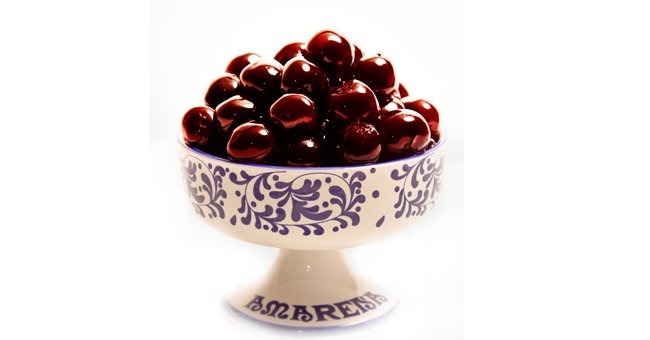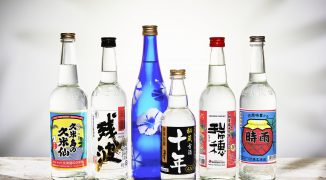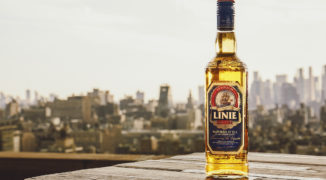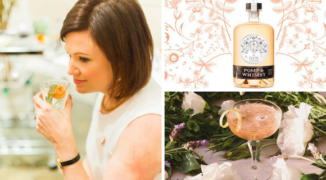Whenever she goes to a bar, Sasha Calabro performs what she calls her “cherry challenge.” After whipping out the little bag of cherries she keeps in her bag for situations like this, she’ll ask the bartender to take out whatever cocktail cherries they currently use. She makes the bartender taste the cherries side by side in a blind taste test, then sits back and waits for the praise to start rolling in.
“Their faces light up when they’ve tried us for the first time,” Calabro said. “There’s no competition on the market that comes close to the flavor of our cherries.”
Calabro is a representative of the Italian company Fabbri, and the cherries in question—small, tart and slightly sour—are the company’s most visible product in the US. More than 100 years in business has established them as one of Italy’s most recognized brands, known for their fruit products, a collection of syrups, purees, and pastes. Now, they’re making a major push into the American cocktail world, where their amarena cherries have become a popular option for bartenders looking for an alternative to sugar-laden, unnaturally red cocktail cherries.
Their attempts seem to be working. Endorsed by everyone from Scott Beattie to Saveur, amarenas are becoming an increasingly common sight behind the bar, and the base for some creative experiments: some bartenders are brandying them, some are infusing them and others are using the syrup to make cherry simple syrup.
Fabbri’s cherries are a departure from what most people expect of their cocktail cherries. Instead of a sickly sweet flavor and thick syrup, the amarenas are bold and tart, with a thin syrup. They’re halal certified, non-GMO, and free of the litany of chemicals and extreme processing that go into supermarket maraschinos (the FDA’s official definition of maraschino cherries: “cherries which have been dyed red, impregnated with sugar and packed in a sugar sirup [sic] flavored with oil of bitter almonds”). The cherries are nonalcoholic, so they’re a neutral addition to any cocktail. They’re also shelf stable, and happen to look very good on a bar’s shelf: they’re housed in a blue and white ceramic vase with an elaborate arabesque pattern.
When Gennaro Fabbri founded Fabbri in 1905 in Italy’s Emilia-Romagna region, the company sold liqueurs. His wife Rachel soon developed a recipe for candied cherries, coaxing the sourness out of the region’s wild black cherries by cooking them for seven days in copper pots with lots of sugar and a blend of spices. Fabbri was so enamored with the cherries that he gave his wife a delicate blue and white ceramic vase as a gift. In 1915, his company started selling the cherries in a similar ceramic crock.rn
Little has changed since then. The company is still owned by the Fabbri family, and the cherries are still made in the same region. Now, they’re made in industrial factories instead of being stirred on Rachel Fabbri’s stovetop, but otherwise the process has remained the same: they still use copper pots, they still cook the cherries for seven days, and no, they won’t tell you the spices they use in their recipe.
“They’re very proprietary. I’ve asked many, many times so many questions and they say ‘Nope, nope, that’s all you need to know!’” said Calabro. “It’s made from spices that are in the area. It’s such a guarded recipe. It’s almost like the secret of Coca-Cola. But better.”
Among Italians, they’re famous, known for their company’s longevity (they’ve remained continually in business for the last century, except for a short period during World War II when Nazis took over their factory) and a memorable collection of quirky TV ads featuring a cartoon pirate. “We’re really well known in the Italian market, in the European market,” Calabro said. “If I pull out the cherries in front of an Italian person, he’s going to tell you a story about his grandmother having amarena Fabbri.”
Over the last century, the cherries slowly made their way from northern Italy to the rest of the world, and they’re now carried in over 100 countries. It was only a few years ago when Fabbri realized that those cherries, so good in the pastry and gelato applications that make up most of their business, would be equally good in cocktails. They started reaching out to the cocktail world, including an appearance at last year’s Tales Of The Cocktail.
Now, with the cherries successfully debuted, they’re working to bring their other products—orgeat and tamarind syrups, a special gelatin to make jellied cocktails—to bartenders’ attention.
Said Calabro: “We’d like to open the front door with our cherries and then show everybody the rest of the ladies.”





